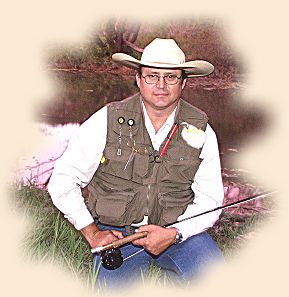It's Wednesday and time to make plans for the weekend fishing.
Having called several people, this turns out to be one of
those rare weekends to where Scott, Jason and I can get together
for a long afternoon of fishing. Plans are made and Sunday
afternoon is kept open for fishing the South San Gabriel.
When we arrive the heat is intensified down in the canyon.
Plenty of water and Gatorade is absolutely necessary. This
time of year wet wading is almost a must. From here out to
September the days will be in the upper nineties and low one
hundreds. People wonder why we wear such big hats!

Today I am taking them well beyond holes fished in the past.
The plan was to wade/hike at a brisk pace and to casually fish
back down river to the bridge where we were parked. About 2.5
miles later we stopped and took a rest under some large shady
oak trees. Rigging up our lines we notice a lot of activity
in the water. This is strictly sight casting, the waters are
extremely clear and with the sun high up in the sky, pictures
can be taken without a polarized lens. Just look at all the
bream in this hole!
First fish of the day was a beautiful Texas Cichlid and the fly
was the San Gabriel.

What was so unusual was this Cichlid was taken on a top-water
San Gabriel Fly. These fish are predominantly nymph eaters.
Soon everyone was catching bream. During the heat of the
mid-day and early afternoon the bass are not so active, but
the bream are and it's almost a fish on every cast!
 As we headed back down river we had time to really pay attention
to the nice pools formed in the river. This time of the year
large sections of the river is actually flowing through the
gravel bars and gives the appearance of a dead dry riverbed.
There are a lot of spring fed pools that hold a large population
of fish. Wading in water that can be as warm as 84 degrees,
a sudden chill will give away the position of a spring feeding
into the river or pool. These springs are also found where
the green ferns are growing on the rocks and the water is
flowing out of the cracks.
As we headed back down river we had time to really pay attention
to the nice pools formed in the river. This time of the year
large sections of the river is actually flowing through the
gravel bars and gives the appearance of a dead dry riverbed.
There are a lot of spring fed pools that hold a large population
of fish. Wading in water that can be as warm as 84 degrees,
a sudden chill will give away the position of a spring feeding
into the river or pool. These springs are also found where
the green ferns are growing on the rocks and the water is
flowing out of the cracks.
We came across some really nice deep clear pools and the
fishing was superb!
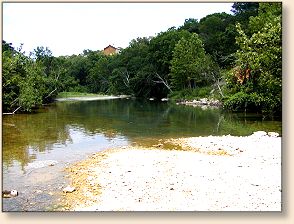

Several species of bream are caught and released that
afternoon and evening. In one particular pool I had
run out of San Gabriel Flies, between giving away,
losing and heavily abused by fish, I just can't seem
to keep enough for a full day of fishing for myself.
Anyway I had to resort to another type of fly and I
did have another tried and true standby, the yellow spider.
I tied it on and placed it out under a Sycamore tree next
to a large limestone boulder. After a few seconds and
the rings had cleared, I gave it a slight twitch and
suddenly the fly was gone! No splash, no explosion of
water, just gone. I set the hook on what I hoped to be
a fish and the fight was on! Turns out to be a large
and very nice bream caught on a yellow spider.
There is a misconception among some fishermen about small
narrow shallow waters not holding any sizable fish. This
simply is not true. There are several narrow channels that
appear to be lifeless on the San Gabriel and are often
passed by. I tell you if there is an overhanging tree
or what appears to be an undercut bank, fish it! In this
small stretch of water there was the combination of an
overhanging tree and an undercut bank. It produced some
really nice bream! Notice the little amount of water in
the channel.
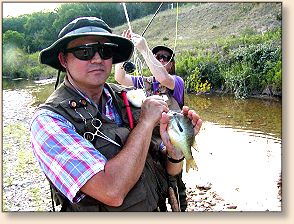
As the day got along, the sun lower and the shadows longer,
bass were observed becoming active. In one pool there was
a submerged ridgeline and several groups were patrolling
this with occasional forays into the shallows terrorizing
the minnows and small perch. It was here that Justin
invented the "Texas Two Fly" method.
Justin gets all excited when there are bass actively feeding.
He starts quivering like a divining rod that has found water.
If one did not know him well they would swear he was having
way too much coffee. Well, the first thing he does is to
throw temptation straight into fates face. By this I mean
he announces he is tying on his last "Mat's Bug" fly and
it has proven to catch bass. I can see all the trees grinning
in anticipation, just waiting for the first cast. One then
two false casts and the bug hits water...hmmm, maybe this
is his day after all. A couple of strips in and one of the
larger bass sees it and went charging into it. Without
breaking speed it just kept going! Justin's rod doubled
over and before the drag could even get the first scream
out...nothing. The rod tip snaps back with slack line
tailing behind.
Ever see a grown man cry? Not a pretty sight. I knew fate
or Murphy would show up sooner or later with his comment
about last best fly, they just seem to do that.
We could see the bass with the bright fly hanging out the side
of his mouth each time he made his pass in our area. Of course
I just could not resist "Hey, Justin, look at that BIG bass!
Wait, there seems to be something hanging out the side of its
mouth! Wow, that looks just like one of your Mat's Bugs.
hehehehe" Evil glares and mutterings best not repeated here.
And not to stop there "Hey Justin, there is a great section
on FAOL on how to tie knots." Glad I was doing the driving
that day.
 Not to be out smarted by a "dumb old fish" He ties on another
fly, a pattern I have not seen before and begins casting again.
After several casts and large bream the fly disappears in a
swirl of water. As Justin sets the hook, we all see that
this was no small fish. During the fight the fish clears
the water twice and it is a large black bass! After several
minutes of fighting, Justin gets the bass in hand. There
in its mouth was Justin's first lost fly! The tippet had
broken 4 inches up from the fly. Can you say wind knot?
He was a happy man that day. A lesson for all of us that
day was to frequently check the line for wind knots, especially
when targeting big fish.
Not to be out smarted by a "dumb old fish" He ties on another
fly, a pattern I have not seen before and begins casting again.
After several casts and large bream the fly disappears in a
swirl of water. As Justin sets the hook, we all see that
this was no small fish. During the fight the fish clears
the water twice and it is a large black bass! After several
minutes of fighting, Justin gets the bass in hand. There
in its mouth was Justin's first lost fly! The tippet had
broken 4 inches up from the fly. Can you say wind knot?
He was a happy man that day. A lesson for all of us that
day was to frequently check the line for wind knots, especially
when targeting big fish.
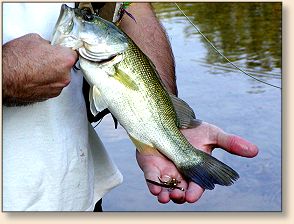
So there you have it, the "Texas Two Fly." For further information
on this method one needs to contact Justin as I have yet to
master this one.
As the day was winding down and we were back to where we parked
the vehicles, we were telling our tales of the day and discussing
the flies that worked and those that did not. I noticed that
for some reason my shoulders and neck were really hurting and
I was not sure as to the reason. While removing our gear I
took my vest off and noticed how darn heavy it was. In checking
all my pockets I found, and remembered, that during the course
of the day I had stopped and collected fossils as I found them.
Casually throwing them in my large vest pocket in the back of
the vest throughout the day had slowly put in enough weight
to strain my shoulders.
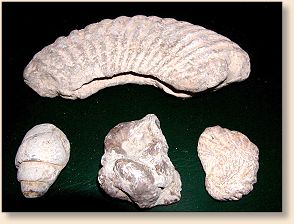
Another day, another adventure and another tale, but now I have
to go and tie more flies. Until next time good fishing!
~
Hillfisher
|

